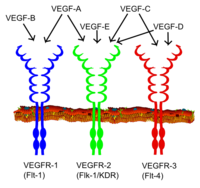
Photo from wikipedia
Transient receptor potential (TRP) cation channel superfamily plays important roles in a variety of cellular processes such polymodal cellular sensing, adhesion, polarity, proliferation, differentiation and apoptosis. The expression of TRP… Click to show full abstract
Transient receptor potential (TRP) cation channel superfamily plays important roles in a variety of cellular processes such polymodal cellular sensing, adhesion, polarity, proliferation, differentiation and apoptosis. The expression of TRP channels is strictly regulated and their de-regulation can stimulate cancer development and progression.In human cancers, specific miRNAs are expressed in different tissues, and changes in the regulation of gene expression mediated by specific miRNAs have been associated with carcinogenesis. Several miRNAs/TRP channel pairs have been reported to play an important role in tumor biology. Thus, the TRPM1 gene regulates melanocyte/melanoma behaviour via TRPM1 and microRNA-211 transcripts. Both miR-211 and TRPM1 proteins are regulated through microphthalmia-associated transcription factor (MIFT) and the expression of miR-211 is decreased during melanoma progression. Melanocyte phenotype and melanoma behaviour strictly depend on dual TRPM1 activity, with loss of TRPM1 protein promoting melanoma aggressiveness and miR-211 expression supporting tumour suppressor. TRPM3 plays a major role in the development and progression of human clear cell renal cell carcinoma (ccRCC) with von Hippel-Lindau (VHL) loss. TRPM3, a direct target of miR-204, is enhanced in ccRCC with inactivated or deleted VHL. Loss of VHL inhibits miR-204 expression that lead to increased oncogenic autophagy. Therefore, the understanding of specific TRP channels/miRNAs molecular pathways in distinct tumors could provide a clinical rationale for target therapy in cancer.
Journal Title: Advances in experimental medicine and biology
Year Published: 2020
Link to full text (if available)
Share on Social Media: Sign Up to like & get
recommendations!